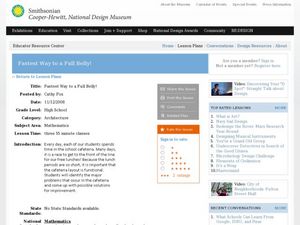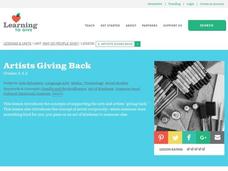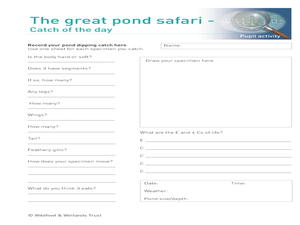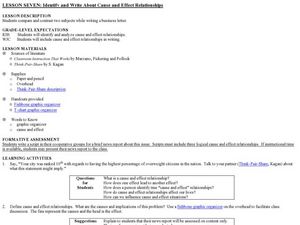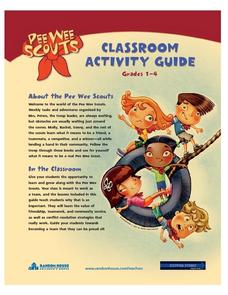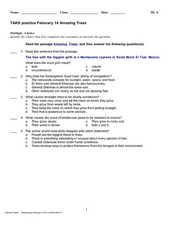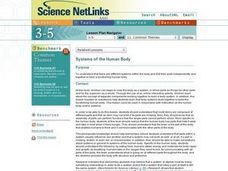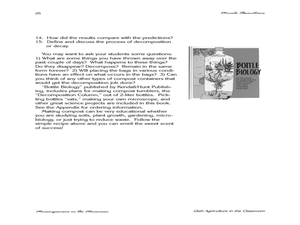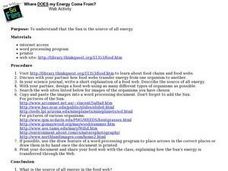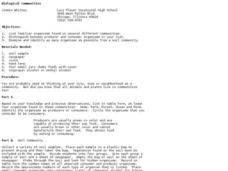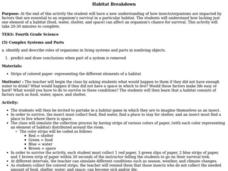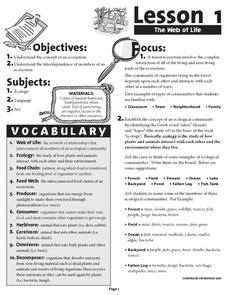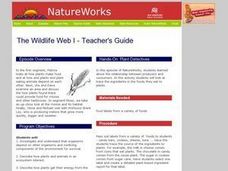Curated OER
Fastest Way to a Full Belly
Students create a scale model of a cafeteria. In this scale lesson, groups improve their actual school cafeteria layout by taking measurements of the structure and redesigning furniture and food serving lines. They create a scale drawing...
Curated OER
Artists Giving Back
Students define serial reciprocity through art and make a classroom goal for the giving back. In this serial reciprocity lesson, students read Camille and the Sunflowers and discuss why the arts are important in communities. Students...
Curated OER
Worm Interviews
Students identify types of worms. For this organisms lesson, students are shown slides of the different types of worms and take notes on each worm. Students answer questions about each worm.
Curated OER
Pond Safari
Learners investigate organisms and animals by examining a nearby pond. In this ecosystem instructional activity, students participate in a field trip to a local pond where they utilize a net to gather animals, plants and pollution items,...
Curated OER
Identify and Write About Cause and Effect Relationships
Students write news reports about current issues. In this writing skills activity, students report about the weight epidemic in the United States as they focus on fast food consumption and how it relates to poor health.
Curated OER
Earth and Space Science
Students investigate space travel. In this science lesson, students discuss the space station and its representation in orbit. They talk about food, travel and survival in space with the correct equipment.
Curated OER
Pee Wee Scouts
Students read books to discover the importance of friendship, teamwork, and community service. After reading the book, they discuss conflict resolution strategies. Students discuss healthy eating food pyramids. They write an essay...
Curated OER
Predicting a Solution to a Problem
Students explore story structure. In this story structure literacy lesson, students listen to the story Ruby's Wish by Shirin Yim Bridges, stopping at points to identify a problem and predict possible solutions which are then written on...
Curated OER
TAKS Practice February 14 Amazing Trees
Are you using Amazing Trees with your pupils? This assessment could be used to gauge their understanding of one passage from the text. The referenced passage from Amazing Trees on which the worksheet is predicated is not included. Beware...
Curated OER
What makes agriculture "sustainable"?
Students define terms and distinguish between the goals and practices used to achieve sustainable agriculture. In this sustainable agriculture instructional activity students demonstrate awareness of the different impacts of...
Curated OER
Where Do Your Veggies Grow?
First graders investigate the origins of vegetables. In this Science instructional activity, 1st graders identify where fruits and vegetables come from. Students describe how people utilize plants.
Curated OER
Biology: Systems of the Human Body
Students examine the different systems of the human body and how they work independently and cooperatively. They complete sevral online interactive projects designed to reinforce how the systems work alone and together. Students make...
Curated OER
Rotten Truth
Students complete activities to study decomposition. In this decomposition lesson, students work in pairs to observe a decay buffet experiment. Students keep compost bag journals. Students define and discuss the process of decomposition.
Curated OER
Breads And Nutritional Labels
Seventh graders investigate the concept of a nutritional label used on bread products. They read different labels in order to strengthen reading skills and interpreting nutritional information. The information is used in order to create...
Curated OER
Organizational Patterns: Comparison and Contrast Writing
Learners write an essay comparing and contrasting their school experiences. Through guided practice, they create an outline of their elementary school experience and middle school experience. Using their outlines, students synthesize...
Curated OER
Where Does My Energy Come From?
Learners gain an understanding that the Sun is the source of all energy. With a partner, they examine various web sites to explore food chains and food webs, later sharing their findings with the class.
Curated OER
Biological Communities
Students identify consumers and producers in different communities. Students collect a variety of soil samples and record organisms found in the samples.
Curated OER
Habitat Breakdown
Fourth graders gain an understanding of how insects/organisms are impacted by factors that are essential to an organism's survival in a particular habitat. They see how lacking just one element of a habitat can affect an organisms chance...
Curated OER
The Web of Life
Students participate in a game in which they discover the balance of life in the ocean. They identify different organisms that rely on different types of food. They answer questions to complete the lesson.
Curated OER
RIDE THE WILD LEAF
Learners identify and interpret that leaves provide food for new trees and plants. Students cut out leaves and glue them on the appropriate
number on included worksheet. Learners collect different types of leaves and make leaf rubbings....
Curated OER
WHY WE AREN'T FILTER FEEDERS
Students describe three methods of obtaining food: scavenging, filter feeding, and hunting. They describe three methods of obtaining food: scavenging, filter feeding, hunting, and list at least two reasons why humans are not considered...
Curated OER
Feeding Paramecia
Young scholars prepare a slide of Paramecium cultures and observe (through a microscope) the organism's thin transparent membrane and what happens as they "feed" them stained yeast cells. They sketch the path the ingested yeast takes as...
Curated OER
The Wildlife Web I
Students explore the relationship between producers and consumers. In this activity, they trace the ingredients in the foods they eat to plants. Supplement to Natureworks episode from New Hampshire Public Television, but activities may...
Curated OER
Who Can Harvest A Walleye?
Seventh graders investigate the concept of how an ecosystem is put together while conducting research using a variety of resources. They correctly differentiate between a herbivore and carnivore by placing them in the order of hierarchy...
Other popular searches
- Con Pair Organic Foods
- Organic Foods Taste
- Non Organic Foods
- Com Pair Organic Foods
- California Organic Foods
- Compair Organic Foods
- Conpair Organic Foods
- Organic Foods Lesson Plan
